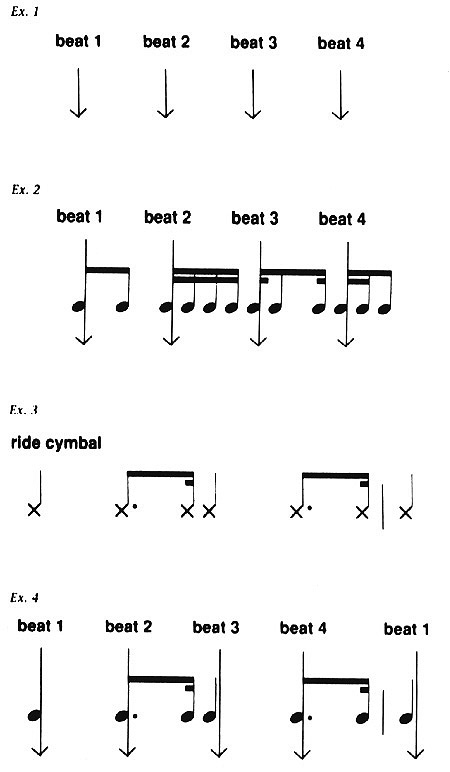Welcome to PaulWertico.com!
Lock In The Pulse
In The Time Line
In the last few articles I've made reference to developing the ability to feel a strong quarter-note pulse, and how I believe that in doing so, you will form a more solid basis for your playing. Now I'd like to share something that should help those of you who sometimes have difficulty in understanding the concept of even pulse.
First, in visualizing what time is, take a look at Ex. 1. In this diagram, I've drawn four vertical lines. This can be called the time line. Here, each line represents a beat.
Implanted on top of this time line are rhythmic figures such as in Ex. 2. Here you can see how the rhythms fit on and inside the time line. When we subdivide rhythms while feeling the pulse clearly inside the rhythm, there seems to be more weight to the sound. Furthermore, the rhythm seems to have more of an inner flow, thus giving it a natural feel of momentum. I'm always shocked when I get a student or hear a drummer who will play rhythms as if they are hanging out in outer space. No time feel, no flow. Just a bunch of notes strung together with no purpose. Of course, some music has rhythmic figures that occur outside of a set pulse, but the majority of music most of us drummers play requires us to lock into a tempo and groove. The following is a typical case.
Look at Ex. 3. Most of you will recognize this as the standard jazz ride cymbal pattern. Simple enough to play, right? But even here I've had a number of new students, some with a good working knowledge of the drum set, that could not execute this properly. In trying to play the dotted-eighth-and-sixteenth figure, some students will pull the 3 of this pattern ahead of where the 3 really is. The same happens to the 1 of the second bar, and so on.

The result looks like Ex. 4. Now, if you're going for this effect intentionally, fine. But almost everyone I've heard do this had no idea that they were doing it. In this case I'll have them concentrate and play only quarter-notes. Once they're comfortable with that, and the quarter-notes are grooving, then I'll have them drop in the dotted-eighth-and-sixteenth, all the while still feeling the quarter-notes. This has worked in every case I've encountered.
By having students focus on the quarter-note pulse, as well as to think of rhythms on and inside the time line, I've been able to help them with their time problems. It's also helped others develop their ability to add "feel" to their playing as well as subdivide better.
Images and Information fromDrums & Drumming November 1990, page 62